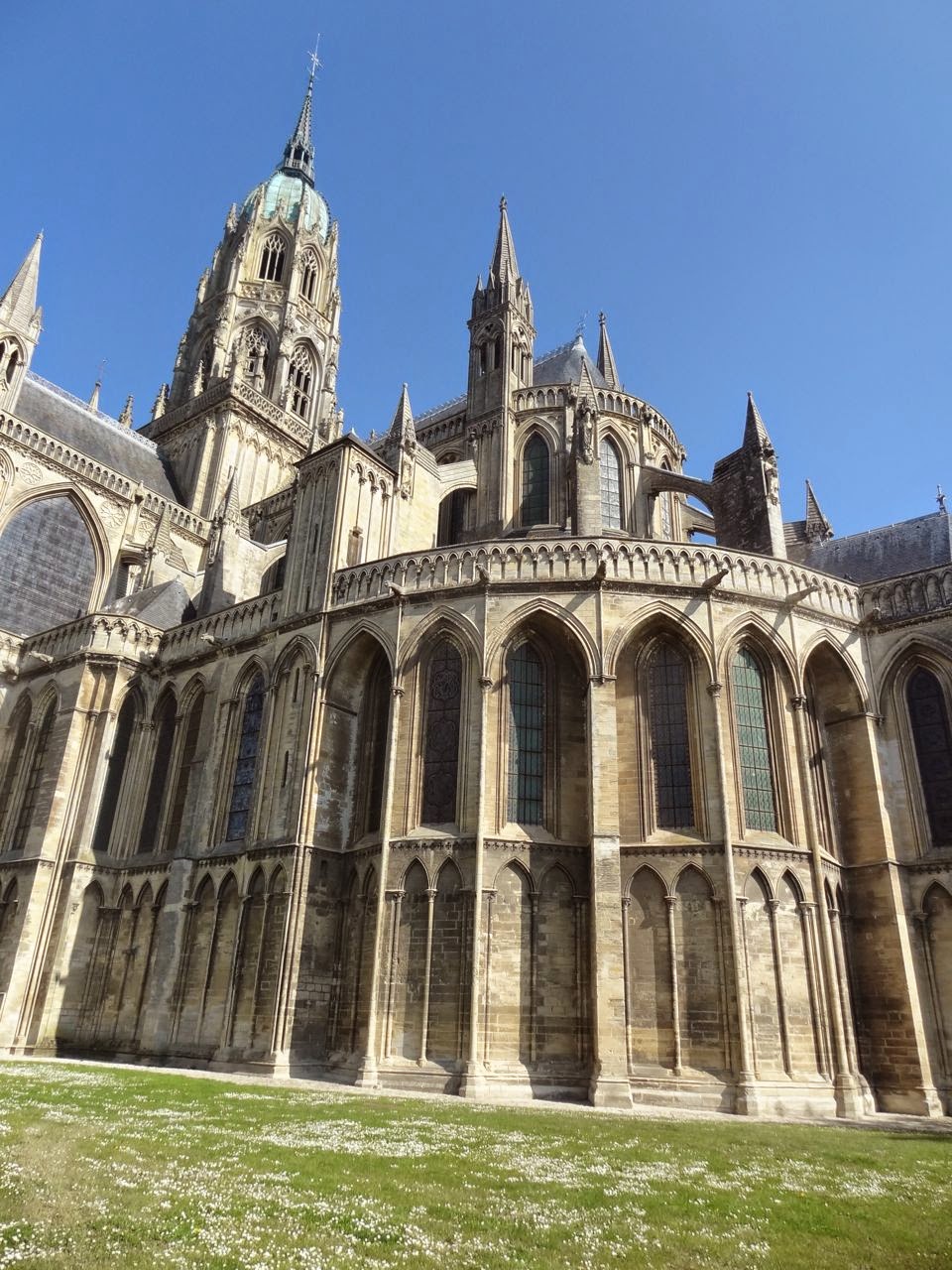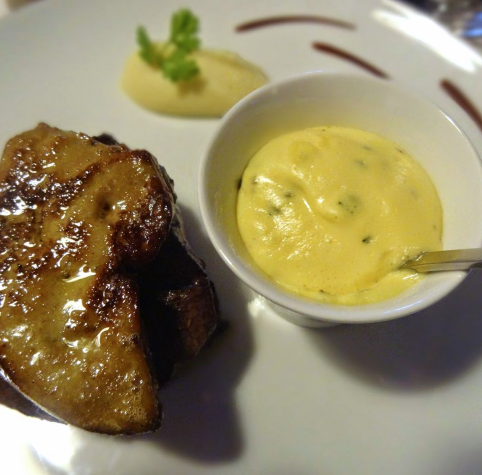Nestled in the northern French countryside, in the county of Calvados, not far from the English Channel, is the beautiful city of Bayeux with its perfectly preserved medieval centre, magnificent cathedral and world-famous tapestry, which depicts the events leading up to the Norman conquest of England. Around the cathedral, the historic centre, untouched during the events of 1944, offers a rich heritage of cobblestone streets lined with small shops and Norman style timbered houses dating from the 17th century. As one approaches the town, Bayeux’s cathedral spires dominate the horizon. A spectacular architectural gem, the Cathédrale Notre-Dame is a mixture of Norman, Romanesque and Gothic architecture, and was also the original home of the famed Bayeux Tapestry. Woven in 1066 by Reine Mathilde, wife of William the Conqueror to commemorate events in the Norman Conquest of England, it's one of the world's oldest tapestries still intact.
The magnificent Cathédrale Notre-Dame in Bayeux, inaugurated by William the Conqueror in 1077
The spectacular bell tower of the cathedral
The south transept portal features sculpted scenes that show the life of Thomas Becket, the Archbishop of Canterbury who was assassinated in Canterbury Cathedral on the orders of King Henry II of England
The Gothic choir was built in 1230
The impressive barrel-vaulted ceiling
Ornate neo Classical carvings with a Baroque influence, decorate the sounding board over the pulpit at Bayeux Cathedral
A gated chapel inside the cathedral
Stained-glass window in south arm of transept, representing bishops and saints of Bayeux
Detail of a fresco inside the cathedral
Statue of St George slaying the dragon
15th-century frescoes in the crypt of the cathedral
The Bayeux Tapestry Museum
The world-famous Bayeux Tapestry is the reason why most people come to Bayeux. Woven in 1066 by Reine Mathilde, wife of William the Conqueror to commemorate events in the Norman Conquest of England, it's one of the world's oldest tapestries still intact. The tapestry tells the story of William the Conqueror in 1066 as he conquered the English troops at the battle of Hastings, and is remarkable both as a source of 11th-century history and as a work of art, as it provides a true glimpse into life in the Middle Ages. The Tapestry stretches 231 feet long and was made of a seamless strip of linen, embroidered with eight colours of woollen thread, in a needlework panorama of 72 individual scenes, and 1512 figures, with identifying Latin inscriptions, of the Norman Conquest. The tapestry tells of Harold’s failure to honour the oath he gave at Bayeux recognizing his cousin William’s right to succeed Edward the Confessor, and the consequences that followed. Recognized by UNESCO on it's 'Memory of the World' register, the Bayeux Tapestry is one of the world’s greatest treasures. Formerly displayed in the cathedral, the Tapestry is now preserved in the Bayeux Tapestry Museum.
Scene 1 : King Edward the Confessor and Harold Godwinson at Winchester
Norman soldiers riding into battle
Harold before he became king, at the ceremony where he gave his oath
Sample of the stitching on the tapestry which is over 1000 years old
Bayeux is also known for it's many restaurants which feature traditional Normandy cuisine. Conveniently located across from the Cathédrale Notre-Dame on Rue Larcher, we discovered Le Petit Normand, a charming little restaurant with a menu of dishes typical of the region, and delicious wines by the glass. Starting with a chilled white Burgundy and deep red St Emilion, we decided on the Pâté de Campagne and Terrine de Foie Gras as appetizers, and followed with two of the restaurant's signature dishes — Tatin de Cochon de Bayeux Sauce Camembert and Côte de Veau à la Normande. The imaginative and delicious Tatin de Cochon was a savoury adaptation of a traditional tart au pommes, filled with a herbed pork and rich creamy camembert and topped with butter poached local apples. To finish, no trip to Normandy would be complete without a glass of Calvados, the golden elixir of Basse-Normandie.
Le Petit Normand in Bayeux
The charming original stone wall interior of Le Petit Normand
The menu features traditional French Normandy cuisine
A lovely fresh tulip on our window-side table
A glass of white burgundy
Pâté de Campagne
Terrine de Foie Gras
Tatin de Cochon de Bayeux Sauce Camembert
The 'Tatin de Cochon' was rather like a savoury apple galette with a creamy Camembert sauce
Côte de Veau à la Normande with a mushroom sauce
A glass of Normandy Calvados
Calvados is a delicious apple brandy from the French region of Lower Normandy, and is distilled from cider made from specially grown and selected apples. The fruit is harvested, either by hand or mechanically, and pressed into a juice that is fermented into a dry cider, then distilled into eau de vie. After two years of aging in oak casks, it can be sold as calvados. The longer it's aged, the smoother the drink becomes, with a maturation that can go on for several years. After our lovely lunch at Le Petit Normand, we were inspired to explore the old centre of Bayeux for a bottle of aged Calvados to bring home.
Walking through Bayeux after our lunch, looking for a bottle of Calvados to take home
A medieval house in the centre of old Bayeux
Le Moulin de l'Hôpital, an old grist mill on the Aure River in Bayeux
We brought back a bottle of Marcel Breton Calvados Vieille Réserve, which we hope to enjoy with homemade apple galette this summer from apples from our garden
Côte de Veau à la Normande
Serves 4
4 veal chops
2 tbsp Calvados
1 lb cremini mushrooms, cleaned and sliced
1 oz butter
4 cups créme fraîche
2 tablespoons oil
1 bunch chives, minced
salt and pepper
In a large skillet, heat the oil and brown the chops over high heat, then flame with the Calvados; remove and keep warm. Place the butter in the pan, then add the mushrooms, stirring occasionally. After 5 minutes, add the cream, salt and pepper, reduce heat to low and cook for another 5 minutes. Place the chops in the sauce, cover and gently simmer for 10 minutes. Serve the veal with the mushroom sauce and garnish with chopped chives.
Normandy Apple Galettes with Frangipane
Serves 4
1 package puff pastry dough, defrosted
2 tbsp flour, for dusting
2 apples
1 tbsp lemon juice
1 tbsp sugar
1/2 tsp ground cinnamon
1 egg yolk
1 tsp cream
Frangipane:
4 tbsp unsalted butter
1/2 cup granulated sugar
1 large egg
1 tbsp all-purpose flour
1/2 cup slivered almonds, ground in a food processor
1/4 tsp vanilla extract
1/4 tsp almond extract
pinch salt
1 tbsp cream
For the frangipane, cream the butter and sugar with an electric mixer. Add in egg, and mix until incorporated. Add in the ground almonds, extracts, salt, and cream. Mix well. Mixture should be light and creamy.
For the pastry, lightly dust the working surface with flour. Unwrap the puff pastry dough and lay flat. Use a rolling pin to flatten it out to about 10"x12". Using a small upturned bowl or mug as "cookie cutters", make four round disks of puff pastry. Place them on a cookie sheet lined with parchment paper. Refrigerate.
Peel the 2 apples, cut them into quarters, and with a paring knife, remove seeds and stems. Place them in a large bowl of water with lemon juice. This will stop the apples form browning. Pull each apple quarter from the water and cut into very thin slices. Return slices to lemon water and set aside.
Preheat oven to 400°F. Take the pastry disks out of the refrigerator, and using a fork, make several marks in the centre. Spread 2 tablespoons of frangipane on the center of each disk, leaving a half inch border around the edges.
With a paper towel, dry off a few apple slices at a time and place decoratively on top of the frangipane, on each pastry round. Mix cinnamon and sugar in a small bowl and set aside. Mix the egg yolk and cream in a small bowl and set aside. Remove the pastries from the refrigerator, and sprinkle the apple slices with the cinnamon-sugar mixture. Brush the edges of the pastry dough with the egg wash, then bake for 15-20 minutes, until the apples are tender and the pastry is puffed and golden brown.
Remove to a wire rack to cool or serve while while warm with a scoop of vanilla or butter pecan ice cream.



































































